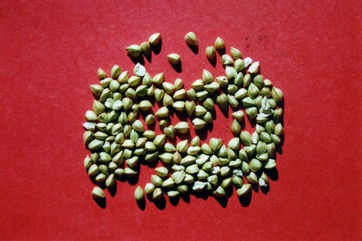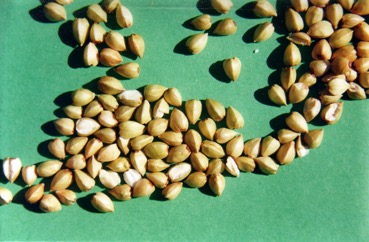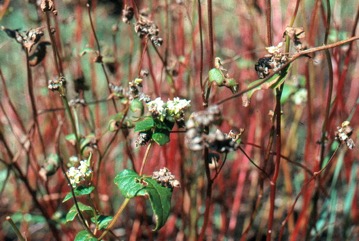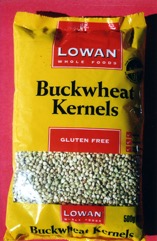Buckwheat, Japanese buckwheat, Silverhull buckwheat

It is a temperate plant. It can be grown at high altitudes in the tropics. It will grow on poor soils. It prefers rich soils and a protected sunny position. It can grow in acid soils. It is resistant to frost but damaged by drought. In Nepal it grows between 1000-2500 m altitude. It can grow up to 4,400 m altitude. In Uttar Pradesh it grows up to 3000 m altitude. In Yunnan.
Also known as:
Al-Hintta, Al-Swdaa, Brank, Bro, Buchweizen, Chutia lofa, Daran, Dayat, Dhemsi sak, Dongthe, Doron, Fafra, Fagopiro, Gamrus, Grano saraceno, Helangala, Ka-la, Koti, Kotu, Kyoubaku, Lompuk, Mach ba-goc, Mariwo, Memil, Mithe phaper, Navadna ajda, Notch-seeded buckwheat, Obul, Ogla, Ogli, Oogal, Phanpar, Phapar, Phaphar, Phaphara, Phaphra, Qiao mai, Sagad, Saracen, Sarrasin, Shari-mam, Soba, Tian qiao mai, Titaphapur, Trigo-sarraceno, Varimbazahamainty, Wakha-yendem
Synonyms
- Fagopyrum cereale Raf.
- Fagopyrum sagittatum Gilib. [Invalid]
- Fagopyrum vulgare Hill, nom. inval.
- Polygonum emarginatum Gilib.
- Polygonum fagopyrum L.
- and others
Edible Portion
- Seeds, Leaves, Flowers
Where does Buckwheat grow?
Found in: Africa, Asia, Australia, Austria, Belarus, Belgium, Bhutan, Botswana, Brazil, Britain, Bulgaria, Canada, Central Africa, Central Asia, China, Congo DR, Cuba, Denmark, East Africa, England, Ethiopia, Europe, Finland, France, Germany, Greece, Himalayas, Hungary, India, Indochina, Indonesia, Iran, Iraq, Ireland, Italy, Japan, Kazakhstan, Kenya, Korea, Korea N, Kyrgyzstan, Laos, Latvia, Lithuania, Macedonia, Madagascar, Manchuria, Mongolia, Mozambique, Myanmar, Nepal, Netherlands, New Zealand, Moldova, North America, Northeastern India, Pacific, Pakistan, Papua New Guinea, PNG, Philippines, Poland, Reunion, Russia, Scandinavia, SE Asia, Serbia, Siberia, Sikkim, Slovenia, South Africa, Southern Africa, South America, Spain, Sri Lanka, Sweden, Tajikistan, Tanzania, Tasmania, Thailand, Tibet, Uganda, Ukraine, United States, Vietnam, Zambia, Zimbabwe
Notes: The plant contains rutin useful for blood conditions. The plant inhibits the germination of other seeds for a period of time. Seeds are 11% protein.
Status: It is a commonly cultivated food plant. It is sold in local markets. Nine countries produce thousands of tons.
Growing Buckwheat, Japanese buckwheat, Silverhull buckwheat
Cultivation: Plants are grown from seed.
Edible Uses: CAUTION: The seeds are used mainly for flour and stock feed. Seeds are bitter. If they are eaten in large amounts they can produce an unpleasant skin disorder. The seeds are eaten in porridge and biscuits etc. The seeds can be made into flour and eaten in pancakes, noodles and breads or for thickening soups and gravies. Seeds can be soaked overnight then sprouted and eaten. The tender leaves and shoots are cooked and eaten. The young leaves can be stored for 4-5 days after harvest.
Production: Seeds usually germinate in 5 days. It has a very short growing period from sowing to maturity. It can produce a crop of leaves in 8 weeks and seeds in 12 weeks. Seed ripen irregularly over several weeks making harvesting difficult. Under cool conditions plants flower in 7-9 months. Commercial grain yields in Australia have been up to 2.5 tonnes/ha. In India yields of 600-800 kg/ha are achieved.
Nutrition Info
per 100g edible portion| Edible Part | Energy (kcal) | Protein (g) | Iron (mg) | Vitamin A (ug) | Vitamin c (mg) | Zinc (mg) | % Water |
|---|---|---|---|---|---|---|---|
| Seed | 336 | 10.3 | 3 | - | - | - | 11.3 |
Buckwheat, Japanese buckwheat, Silverhull buckwheat Photos




References
Ambasta, S.P. (Ed.), 2000, The Useful Plants of India. CSIR India. p 218
Anderson, E. F., 1993, Plants and people of the Golden Triangle. Dioscorides Press. p 211
Angami, A., et al, 2006, Status and potential of wild edible plants of Arunachal Pradesh. Indian Journal of Traditional Knowledge 5(4) October 2006, pp 541-550
Aryal, K. P., et al, 2018, Diversity and use of wild and non-cultivated edible plants in the Western Himalaya. Journal of Ethnobiology and Ethnomedicine (2018) 14:10
Bandyopadhyay, S. et al, 2009, Wild edible plants of Koch Bihar district, West Bengal. Natural Products Radiance 8(1) 64-72
Bianchini, F., Corbetta, F., and Pistoia, M., 1975, Fruits of the Earth. Cassell. p 28
Bodkin, F., 1991, Encyclopedia Botanica. Cornstalk publishing, p 469
Brouk, B., 1975, Plants Consumed by Man. Academic Press, London. p 35
Brown, D., 2002, The Royal Horticultural Society encyclopedia of Herbs and their uses. DK Books. p 211
Burkill, I.H., 1966, A Dictionary of the Economic Products of the Malay Peninsula. Ministry of Agriculture and Cooperatives, Kuala Lumpur, Malaysia. Vol 1 (A-H) p 1009
Campbell, C.G., 1979, Buckwheat, in Simmonds, N.W., (ed), Crop Plant Evolution. Longmans. London. p 235
Cerne, M., 1992, Wild Plants from Slovenia used as Vegetables. Acta Horticulturae 318
Dangol, D. R. et al, 2017, Wild Edible Plants in Nepal. Proceedings of 2nd National Workshop on CUAOGR, 2017.
Dorjey, K., 2015, Exploration of Plant based Traditional Knowledge from Sham region of Ladakh (J. & K.), India. Journal of Plant Development Sciences Vol. 7 (5) : 429-433.
Dutta, U., 2012, Wild Vegetables collected by the local communities from the Churang reserve of BTD, Assam. International Journal of Science and Advanced Technology. Vol. 2(4) p 121
Facciola, S., 1998, Cornucopia 2: a Source Book of Edible Plants. Kampong Publications, p 184
Flora of China @ efloras.org Volume 5
Flora of Pakistan. www.eFloras.org
Fox, F. W. & Young, M. E. N., 1982, Food from the Veld. Delta Books. p 304
French, B.R., 1986, Food Plants of Papua New Guinea, A Compendium. Asia Pacific Science Foundation p 347
Gangwar, A. K. & Ramakrishnan, P. S., 1990, Ethnobotanical Notes on Some Tribes of Arunachal Pradesh, Northeastern India. Economic Botany, Vol. 44, No. 1 pp. 94-105
Giménez-Bastida, J. A. and Zieliński, H. (2015), Buckwheat as a Functional Food and Its Effects on Health, Journal of Agricultural and Food Chemistry, 63 (36), pp 7896–7913.
Haq, N., Anthony, K., Sarwar, M., and Ahmad, Z. (eds.), 1998, Underutilized Crops of Pakistan. Plant Genetic Resources Institute. p 13
Hedrick, U.P., 1919, (Ed.), Sturtevant's edible plants of the world. p 305
Heyne, K., 1927, p 599
Hibbert, M., 2002, The Aussie Plant Finder 2002, Florilegium. p 100
Hu, Shiu-ying, 2005, Food Plants of China. The Chinese University Press. p 370
Irving, M., 2009, The Forager Handbook, A Guide to the Edible Plants of Britain. Ebury Press p 168
Jansen, P.C.M., 2006. Fagopyrum esculentum Moench. [Internet] Record from Protabase. Brink, M. & Belay, G. (Editors). PROTA (Plant Resources of Tropical Africa), Wageningen, Netherlands. < http://database.prota.org/search.htm>. Accessed 16 October 2009.
Jardin, C., 1970, List of Foods Used In Africa, FAO Nutrition Information Document Series No 2.p 3
Jain et al, 2011, Dietary Use and Conservation Concern of Edible Wetland Plants at Indo-Burma Hotspot: A Case Study from Northeast India. Journal of Ethnobiology and Ethnomedicine 7:29 p 6
Jessop, R., 1995, Buckwheat Studies on the Northern Tablelands of NSW. Australian New Crops Newsletter 14.2 No 4.
Joshi, N., et al, 2007, Traditional neglected vegetables of Nepal: Their sustainable utilization for meeting human needs. Tropentag 2007. Conference on International Agricultural Research for Development.
Joshi, N. & Siwakoti, M., 2012, Wild Vegetables Used by Local Community of Makawanpur District and Their Contribution to Food Security and Income Generation. Nepal Journal of Science and Technology Vol. 13, No. 1 (2012) 59-66
Khanal, R., et al, 2014, Documenting abundance and use of underutilized plant species in the mid hill region of Nepal. ECOPRINT 21: 63-71, 2014
Kiple, K.F. & Ornelas, K.C., (eds), 2000, The Cambridge World History of Food. CUP p 1739
Kishor, A., et al, 2018, Wild Food Plants of Himachal Pradesh: A Review. Plant Archives Vol. 18 No.2 pp. 2737-2751
Kumar, P. D., et al, 2015, Ethnobotanical Knowledge and Usage of Wild Plants in Theog Forest Division, Himachal Pradesh, North Western Himalaya. The Journal of Ethnobiology and Traditional Medicine. Photon 124(2015) 922-935
Kunwar, R.M., et al, 2012, Underutilized Plant Species in Far West Nepal. J. Mt. Sci. (2012) 9:589-600
Lazarides, M. & Hince, B., 1993, Handbook of Economic Plants of Australia, CSIRO. p 113
Li, S., et al, 2020, Monpa, memory, and change: an ethnobotanical study of plant use in Mêdog County, South-east Tibet, China. Journal of Ethnobiology and Ethnomedicine. (2020) 16:5 p 22
Liu, Yi-tao, & Long, Chun-Lin, 2002, Studies on Edible Flowers Consumed by Ethnic Groups in Yunnan. Acta Botanica Yunnanica. 24(1):41-56
Lokho, K. & Narasimhan, D., 2013, Ethnobotany of Mao-Naga Tribe of Manipur, India. Pleione 7(2): 314-324
Macmillan, H.F. (Revised Barlow, H.S., et al), 1991, Tropical Planting and Gardening. Sixth edition. Malayan Nature Society. Kuala Lumpur. p 353
Manandhar, N.P., 2002, Plants and People of Nepal. Timber Press. Portland, Oregon. p 232
Manju, S., and Sundriyal, R. C., 2001, Wild Edible Plants of the Sikkim Himalaya: Nutritive Values of Selected Species. Economic Botany 55(3): 377-390
Menninger, E.A., 1977, Edible Nuts of the World. Horticultural Books. Florida p 148
Methodus 290. 1794
Negi, K.S., 1988, Some little known wild edible plants of U.P. Hills. J. Econ. Tax. Bot. Vol. 12 No. 2 pp 345-360
Negi, P. S. & Subramani, S. P., 2015, Wild Edible Plant Genetic Resources for Sustainable Food Security and Livelihood of Kinnaur District, Himachal Pradesh, India, International Journal of Conservation Science. 6 (4): 657-668
Neogi, B., Prasad, M. N. V. and Rao, R. R., 1989, Ethnobotany of Some Weeds of Khasi and Garo Hills, Meghalaya, Northeastern India. Economic Botany 43(4): 471-479
Paczkowska, G . & Chapman, A.R., 2000, The Western Australian Flora. A Descriptive Calatogue. Western Australian Herbarium. p 460
Patiri, B. & Borah, A., 2007, Wild Edible Plants of Assam. Geethaki Publishers. p 113
Pham-Hoang Ho, 1999, An Illustrated Flora of Vietnam. Nha Xuat Ban Tre. p 754
Pieroni, A.,& Giusti, M. E., 2009, Alpine Ethnobotany in Italy: Journal of Ethnobiology and Ethnomedicine. 5:32
Plants for a Future database, The Field, Penpol, Lostwithiel, Cornwall, PL22 0NG, UK. http://www.scs.leeds.ac.uk/pfaf/
Plowes, N. J. & Taylor, F. W., 1997, The Processing of Indigenous Fruits and other Wildfoods of Southern Africa. in Smartt, L. & Haq. (Eds) Domestication, Production and Utilization of New Crops. ICUC p 191
Polunin, O., & Stainton, A., 2006, Flowers of the Himalaya, Oxford India Paperbacks. p 347
PROSEA (Plant Resources of South East Asia) handbook Volume 10 Cereals. p 95
Purseglove, J.W., 1968, Tropical Crops Dicotyledons, Longmans. p 640
Rana, D., et al, 2019, Ethnobotanical knowledge among the semi-pastoral Gujjar tribe in the high altitude (Adhwari’s) of Churah subdivision, district Chamba, Western Himalaya. Journal of Ethnobiology and Ethnomedicine (2019) 15:10
Rana, J.C. et al, 2011, Genetic resources of wild edible plants and their uses among tribal communities of cold arid regions of India. Genetic Resources and Crop Evolution. 59:135-149
Ruiters-Welcome, A. K., 2019, Food plants of southern Africa. Ph.D. thesis. Univ. of Johannesburg p 91
Sachula, et al, 2020, Wild edible plants collected and consumed by the locals in Daqinggou, Inner Mongolia, China. Journal of Ethnobiology and Ethnomedicine (2020) 16:60
Self, M., 1999, Phoenix Seeds Catalogue p 4
Singh, A. G., Panthi, M. P., & Tewari, D. D., 2012, Wild Plants Used as Vegetable in Rupandehi District of Nepal and their Ethnomedicinal Importance. J. Nat. Hist. Mus. Vol. 26, 2012, 111-125
Solomon, C., 2001, Encyclopedia of Asian Food. New Holland. p 158
Song, M., et al, 2013, Traditional knowledge of wild edible plants in Jeju Island, Korea. Indian Journal of Traditional Knowledge. 12(2) pp 177-194
Taram, M., et al, 2018, Wild Food Plant Resources of Komkar Adi Tribe of Upper Siang District in Arunachal Pradesh, India. Bulletin of Arunachal Forest Research, Vol. 33(2), 27-35
Thakur, D., et al, 2017, Why they eat, what they eat: patterns of wild edible plants consumption in a tribal area of Western Himalaya. Journal of Ethnobiology and Ethnomedicine (2017) 13:70
Tsering, J., et al, 2017, Ethnobotanical appraisal on wild edible plants used by the Monpa community of Arunchal Pradesh. Indian Journal of Traditional Knowledge. Vol 16(4), October 2017, pp 626-637
USDA, ARS, National Genetic Resources Program. Germplasm Resources Information Network - (GRIN). [Online Database] National Germplasm Resources Laboratory, Beltsville, Maryland. Available: www.ars-grin.gov/cgi-bin/npgs/html/econ.pl (10 April 2000)
van Wyk, B., 2005, Food Plants of the World. An illustrated guide. Timber press. p 193
van Wyk, Be, & Gericke, N., 2007, People's plants. A Guide to Useful Plants of Southern Africa. Briza. p 10
World Checklist of Useful Plant Species 2020. Royal Botanic Gardens, Kew
www.efloras.org Flora of China
Zhang, L., et al, 2016, Ethnobotanical study of traditional edible plants used by the Naxi people during droughts. Journal of Ethnobiology and Ethnomedicine. 12:39